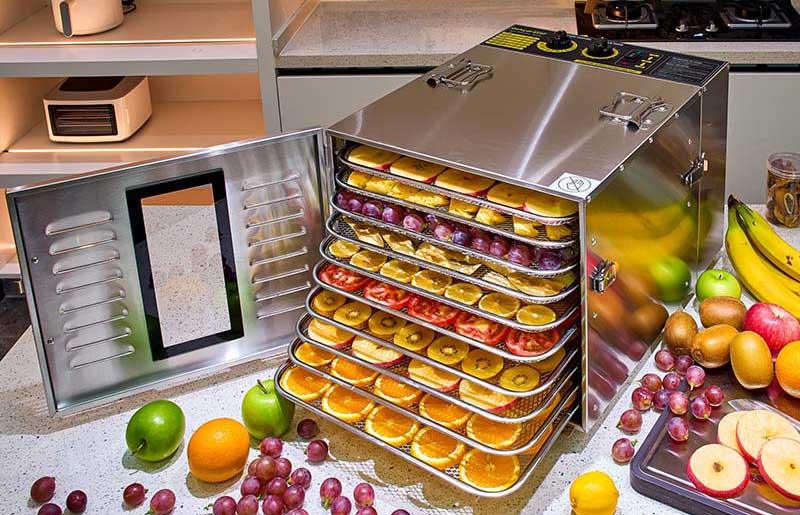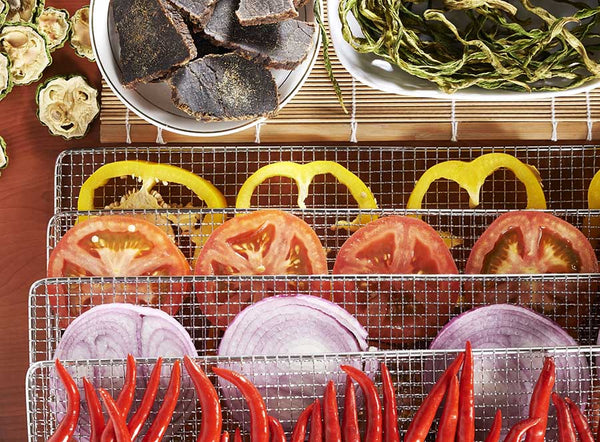Pretreat Ments Methods

Introduction
Drying is one of the easiest ways to preserve most types of foods including meats, fish, vegetables, herbs, fruits, nuts and seeds.Dried foods can be kept at room temperature. Properly stored, they are safe to eat for weeks,months,or even years.
Types of food not suitable for home drying generally include high-fat foods.such as avocados,olives,and cheese.Eggs can give you mixed results. Though salad greens won't come back to life,dried vegetable salads are possible,and powdered dried vegetables and fruits can be used for beverages, soups,and sauces.
Our Septree food dehydrator provides precise temperature control and stable airflow, which it is easy to operate and produces high-quality dried food products. All dehydrators have a series of stacked or sliding trays or racks to hold the food to be dried.
Our temperature range of 65°to 190°F will allow you to dry all types of foods,from delicate herbs to meat jerkies and everything in between.
In addition to preserving the mentioned types of foods, drying can also be used to make various snacks and treats. For example, you can make banana chips, apple rings, dried mango slices, beef jerky, homemade granola bars, and even fruit leather. Dried herbs can be used in cooking and baking to enhance the flavor of dishes, while dried fruits can be rehydrated and used in desserts or added to trail mixes.

Drying also has several benefits. Firstly, it helps to concentrate the flavors of the food, resulting in a more intense taste. Secondly, it removes the water content from the food, making it lighter in weight and easier to store and transport. Dried foods also have a longer shelf life compared to fresh foods, reducing the chances of wastage. Furthermore, drying helps to increase the availability of certain nutrients in foods, such as antioxidants and vitamins.
The Septree food dehydrator offers several advantages for efficient and convenient drying. With precise temperature control, you can easily adjust the settings to achieve the desired level of dehydration for different types of foods. The stable airflow ensures even drying, preventing any potential hot spots or unevenness in the final product. This ensures that your dried foods are of high quality and retain their nutritional value.
The dehydrator consists of multiple trays or racks, allowing you to dry large quantities of food at once. This is especially useful when dealing with bulk produce or when you want to prepare snacks for a long period of time. The temperature range of 65°F to 190°F provides flexibility in drying a wide range of foods, accommodating the needs of various recipes and personal preferences.
Overall, the Septree food dehydrator is a reliable and efficient tool for preserving and creating a variety of dried food products. Its user-friendly design and ability to produce high-quality results make it an excellent choice for both beginners and experienced users.
So whether you want to enjoy healthy and flavorful snacks or stock up on ingredients for future use, drying with the Septree food dehydrator is a convenient and effective solution.

Instructions
● Before Dehydrating
● Clean and sanitize the work area and food-preparation tools.
● Wash hands when starting or switching tasks, such as preparing produce and then setting up the dehydrator.
● lf you have cuts or sores on your hands, wear gloves or use utensils to handle food.
● Choose foods in perfect condition drying does not improve quality.
● Keep foods cold until prepared or placed in the dehydrator.
● Choose lean cuts of meat, such as loin, flank, and round; fat turns rancid quickly.
● Aged or ground meats naturally contain higher levels of bacteria and so require pretreat mentor cooking when making jerky.
● Carefully field-dress wild game and precook wild game to destroy any pathogens.
● Do not reuse meat marinades.
● Read more about Drying Meat Safely.
● Do not dehydrate produce with soft spots or bruises that can harbor bacteria.
● Before cutting any produce, thoroughly wash the outside under running water.
● Preheat the dehydrator for at least 10 minutes before loading food onto drying trays.
● To maximize airflow, place all drying trays in the dehydrator, even if they contain no food.
● Do not overload drying trays.
● Space dense, moist foods apart on drying trays to facilitate airflow.
● Condition foods after drying to check for excess moisture before storing
Seal dried foods in clean, sterile, airtight containers.
● Store dried foods in cool, dark places.
● Package food in small batches to avoid reopening and introducing moisture.
● Check dried foods monthly for signs of moisture and re-dry if needed.
● lf mold is discovered in any container, discard all food in the container.
Pretreatments will prevent discoloration of light-colored fruits and vegetables. Deactivation of spoilage enzymes to improve the quality of dried vegetables. lnhibit harmful microorganisms to improve food safety.Ensure uniform drying to improve storage life.
Steam Blanching
Two blanching methods, steam and water, are used to achieve different benefits. Steam blanching places the food on a rack over boiling water (notin boiling water). Cover the pot tightly and start timing immediately.The blanching time depends on the type of food, the size of the food piece sand the intended preparation. lt is used for two reasons.
To prevent discoloration of susceptible fruits and vegetables, such as apples.pears, peaches, apricots, bananas, artichokes, eggplants and potatoes.
Nactivate spoilage enzymes in all dried vegetables to improve quality and storage life.Test for adequate blanching by cutting or biting into a piece.
lt should be tender and crisp (tender near the outside, hard or crisp in themiddle). The blanching times given in my recipe are only guidelines; youare the final judge of whether it has reached the tender-crisp standard.After blanching, drain, pat dry, and place immediately in a dehydrator.
Water Blanching
Blanching is the process of immersing fruits in boiling water to produce tiny cracks that are invisible to the naked eye. It is used only on fruits with firm skins, such as blueberries, cranberries, cherries, figs, grapes and plums.
This process, called "checking" or cracking, opens the pores of the fruit skin to help the fruit dry evenly and completely. After blanching, they are drained, patted dry, and immediately placed in a dehydrator.
Acidulating
Acid prevents discoloration of fruits and vegetables by inactivating the enzymes
that cause oxidation.Prepare the product by soaking in the following solutions for 5 minutes, listed from most effective to least effective. After soaking, drain and pat dry; and immediately place in a dehydrator.
As corbic acid or vitamin C tablets without any additives. Dissolve 3000 mg
(crush 6 500 mg tablets) in 1 gallon of water.
Freshly squeezed or bottled 100% fruit juice without added sugar, such as apple,
cranberry, white grape, lemon, lime, orange, and pineapple.
Commercial antioxidants. They are easy to use, but may contain additives that
produce surreal colors. Use according to package directions. Citric acid powder. Dissolve 1 teaspoon (5 g) of the powder in 1 quart of water.
Sugar Syrups
Sugar slows down the browning of the fruit, although not as much as acid soaking. An added benefit, however, is that fruit simmered in sugar syrup prior to dehydration ends up plump and sweet.
Whether you use sugar syrup or not is a matter of preference.Gently simmer the fruit in the following solution for 1 to 2 minutes. Turn off the heat and let stand for 10 to 30 minutes, or until cool enough to handle.
After simmering, drain and pat dry; and immediately place in a dehydrator. For medium, heavy, or very heavy syrups, dissolve 1/3 cup, 1/2 cup, or 2/3 cup sugar in 3/4 cup water. Syrup strength is a matter of preference, but tart fruit is a candidate for the heaviest (sweetest) syrup.
For honey syrup, replace half of the sugar with honey. For example, for a heavy honey syrup, use 1/4 cup of sugar, 1/4 cup of honey, and 3/4 cup of water.
Salt Solutions
Salt inhibits the growth of microorganisms in fruits, vegetables and meats. For fruits or vegetables, dissolve 2 to 4 tablespoons of table salt or kosher salt in 1 gallon of water. Soak for 5 minutes.
For meats, dissolve 1/2 to 2/3 cup canned/curing salt or table salt in 1 quart of water, or 3/4 to 1 cup kosher salt. Soak in the refrigerator for 4 to 24 hours (the length of time depends on the strength of the brine, the thickness of the meat strips, and how salty you want the meat to be).
Add seasoning to the brine to marinate, if desired. After soaking, drain and pat dry; and immediately place in a dehydrator.
Sodium Nitrite
Sodium nitrite inhibits microbial growth when drying meat. Use only pink curing salt or curing mix "#1"—a "fast" curing salt mixture containing sodium nitrite formulated for home use and follow package instructions precisely. Be aware that pink salt is poisonous if ingested directly, even in small amounts.


Leave a comment